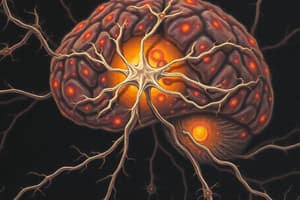Podcast
Questions and Answers
What is the role of oligodendrocytes in the central nervous system?
What is the role of oligodendrocytes in the central nervous system?
- Transmit sensory signals to the brain.
- Provide structural support to neurons.
- Support the metabolic needs of peripheral ganglia.
- Wrap axons in fatty myelin. (correct)
Which type of neuron is primarily responsible for sensory input from the retina?
Which type of neuron is primarily responsible for sensory input from the retina?
- Bipolar neurons. (correct)
- Multipolar neurons.
- Pseudounipolar neurons.
- Unipolar neurons.
What do Nissl bodies indicate in neuronal histology?
What do Nissl bodies indicate in neuronal histology?
- Degeneration of the neuron.
- Presence of microtubules.
- Activation of neurofilaments.
- Ribosomal activity and protein synthesis. (correct)
What contributes to the increased speed of electrical signal transmission in peripheral nerves?
What contributes to the increased speed of electrical signal transmission in peripheral nerves?
What occurs at the nodes of Ranvier?
What occurs at the nodes of Ranvier?
What does the presence of large sensory soma in the dorsal root ganglion (DRG) indicate?
What does the presence of large sensory soma in the dorsal root ganglion (DRG) indicate?
What mechanism is primarily responsible for the transport of proteins within a neuron?
What mechanism is primarily responsible for the transport of proteins within a neuron?
During which prenatal period does myelination of PNS axons begin?
During which prenatal period does myelination of PNS axons begin?
Which cells are responsible for supporting the metabolic needs of sensory soma in the PNS?
Which cells are responsible for supporting the metabolic needs of sensory soma in the PNS?
What type of neuropathy is associated with unmyelinated small diameter axons?
What type of neuropathy is associated with unmyelinated small diameter axons?
Study Notes
Central Nervous System (CNS)
- Neurons transmit rapid electrical signals over long distances.
- Oligodendrocytes wrap axons in fatty myelin to insulate and facilitate signal transmission.
- Types of CNS glial cells include Microglia (immune defense), Astrocytes (support and nutrition), and Ependymal cells (line ventricles).
Peripheral Nervous System (PNS)
- Neurons in the PNS include Schwann cells, which wrap axons to form myelin.
- Satellite cells provide metabolic and chemical support to the neuronal soma in peripheral ganglia.
Neuron Types
- Multipolar Neurons: Motor (efferent) neurons, involved in somatic (skeletal) and autonomic functions; soma located in CNS.
- Bipolar Neurons: Sensory neurons found in the retina, olfactory epithelium, and inner ear; soma located in the dorsal root ganglia (DRG).
- Pseudounipolar Neurons: Sensory (afferent) neurons, relating to somatic and visceral body sensations, including taste; soma located in DRG.
Dorsal Root Ganglia (DRG) Histology
- Large sensory soma present in DRG, characterized by Nissl bodies (rough endoplasmic reticulum) that are basophilic.
- Presence of axons and satellite cells; Nissl bodies are crucial for protein synthesis in neurons.
- Absence of Nissl bodies indicates the axonal initiation point.
Axonal Transport
- Microtubules enable transportation of proteins between distant neuron sites.
- Important components include neurofilaments (intermediate filaments), microfilaments, and mitochondria concentrated at axon terminals.
Myelination in the PNS
- Begins around 11 weeks in embryos, with CNS myelination starting in the third trimester; continues through the first year postnatally.
- Most humans achieve full myelination by the second year after birth.
- Unmyelinated axons may have small diameters, such as certain nociceptive (pain) neurons; these still receive metabolic and ionic support from Schwann cells.
Peripheral Nerve Anatomy
- Connective tissue makes up 50-90% of peripheral nerve mass, providing structural integrity and support.
Nodes of Ranvier
- Small gaps in myelin that facilitate the propagation of electrical signals, preventing signal degradation.
- Schwann cells wrap axons approximately 100 times near the nodes, significantly increasing conduction speed.
Studying That Suits You
Use AI to generate personalized quizzes and flashcards to suit your learning preferences.
Related Documents
Description
Test your knowledge of the central and peripheral nervous systems with this comprehensive quiz. Focus on the roles of neurons, glial cells, and their functions. Practice at the end of the chapter will reinforce your understanding.





